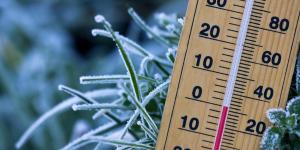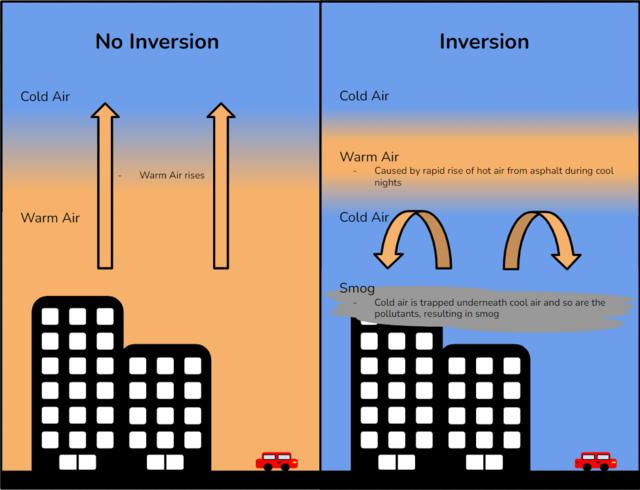What Is Thermal Inversion and How Does It Occur?


Also known as temperature inversion, thermal inversion is a meteorological phenomenon that changes the normal behavior of atmospheric temperature. We may already know that the temperature in the upper layers of the Earth's atmosphere is usually lower than that of the layers below. If we consider air, it usually cools as it rises. However, there are instances when the temperature can increase as we gain altitude, instead of cooling. This meteorological phenomenon is called thermal inversion.
With thedailyECO, we explain more about what is thermal inversion and how does it occur? In addition to know how it occurs, we provide different types of thermal inversion to see examples of it at work.
What is thermal inversion?
Thermal inversion is an atmospheric phenomenon in which temperature increases with altitude instead of decreasing. This is atypical in terms of atmospheric dynamics. Normally, the temperature decreases as we rise in the atmosphere. With a temperature inversion, there is a layer of warm air lying above a layer of colder air near the Earth's surface. This inversion is depicted in the diagram above.

How does thermal inversion occur?
A thermal inversion is generated when atmospheric conditions favor an unusual change in the vertical temperature profile. Under normal conditions, air temperature decreases as we ascend in the atmosphere. As we have explained, this pattern is reversed during a temperature inversion. The temperature increases with altitude rather than decreasing. While this is the way it happens, how thermal version occurs depends on its type.
The type of thermal inversion depends on certain atmospheric factors. These include the location of weather fronts, amount of cloud cover and climactic temperatures. While some may say there are only three, when we consider all the reasons why thermal inversion occurs, we can say there are four main types. We look at these types in the sections below.
Discover more about the composition of the Earth's atmosphere with our article on what is the mesosphere?
Types of thermal inversion
Ground-based thermal inversion
It commonly occurs during clear and calm nights, i.e. little wind or cloud cover. The Earth's surface emits thermal radiation into space, causing the layer of air in direct contact with the surface to cool rapidly. This can result in a layer of colder air near the surface, causing temperatures to rise at higher altitudes.
This process can lead to a nighttime temperature inversion, where a layer of colder air forms near the surface. While this happens, a warmer layer sits above it. Ground-based nocturnal thermal inversion is most common on clear, windless nights as these conditions allow heat to escape more efficiently from the surface into space.
Marine thermal inversion
Marine thermal inversion is a phenomenon related to temperature variations in the atmospheric boundary layer over bodies of water. These include as oceans, seas or lakes. Although the term ‘thermal inversion’ is often associated with the atmosphere over land, it can also occur over water. This phenomenon can have significant impacts on weather conditions and air quality in coastal areas.
Frontal thermal inversion
This type of thermal inversion occurs in association with weather fronts. When a cold air mass advances and replaces a warm air mass, the interface between the two masses can result in a thermal inversion.
In the case of a frontal thermal inversion, it occurs when a warm air mass rises and overlaps a colder air mass. Under normal conditions, the temperature would decrease with altitude, but during a frontal temperature inversion, the layer of warm air lies above the layer of cold air, causing a temperature increase rather than a decrease.
Learn more about weather fronts with our article on the difference between climate and weather.
Subsidence investment
A thermal inversion generated by subsidence is the increase in temperature that occurs due to the gradual descent of a medium or high level layer associated with an anticyclonic system. The descent of this air from higher altitudes causes it to heat up via by compression, giving rise to a layer of hot, dry and highly stable air.
The subsidence process is gradual and can extend over several days. During this time, the subsidence thermal inversion intensifies as it approaches the surface, resulting in the air becoming progressively warmer and drier than the layer of air below. The summits of mountain ranges experience the warm, dry conditions characteristic of a subsidence thermal inversion sooner than lower elevation areas.
Typically, subsidence thermal inversions are most pronounced in late summer and autumn, especially north and east of a persistent high pressure ridge over a region. It can last for for prolonged periods, sometimes several weeks.
Discover more about a meteorological phenomenon that occurs due to changes in atmospheric conditions with our article on what is virga weather?

Effects of thermal inversion
Now we know the different types of thermal inversion and how they occur, you may want to know why they are important. We can better understand this by looking at the effects of thermal inversion on the Earth.
- Pollutant Trapping: thermal inversion can trap pollutants in the lower layer of air. This is because the warmer air at the top acts as a sort of lid, preventing pollutants from dispersing vertically.
- Stable weather conditions: during a temperature inversion, the atmosphere tends to become more stable, meaning there is less vertical mixing of air. This can lead to the buildup of contaminants in lower air layers.
- Effects on air quality: the accumulation of pollutants in the lower air layer can negatively affect air quality, as pollutants can concentrate and persist at higher levels than under normal atmospheric conditions. You can see a diagram of how this works in the diagram above.
Now we know everything we need to know about thermal inversions and how they occur, you may want to know about another weather phenomenon in our guide to what is the cold drop weather phenomenon?
If you want to read similar articles to What Is Thermal Inversion and How Does It Occur?, we recommend you visit our Meteorological phenomena category.







